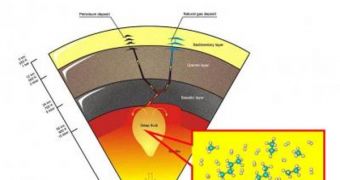Until recently, geologists and scientists believed that hydrocarbons (oil and natural gas) were formed only from living microorganisms that were compressed in the upper layers of the Earth's crust, and heated with high temperatures from the upper mantle. Now, a new research comes to show that it may be, indeed, possible that hydrocarbons be also formed in the upper mantle, as some scientists have proposed. The mantle stretches from underneath the crust to the planet's super-hot core. Its upper part was demonstrated to exhibit all the conditions required for the formation of deep oil and gas deposits.
The reason why the debate as to whether this is possible or not lasted for so long is the fact that oil as we know it is entirely made up of organic material, as in remnants of large amounts of microorganisms. If hydrocarbons form in the mantle, then this means that no organic material can be found in it. The recent study, conducted by scientists from the Carnegie Institution's Geophysical Laboratory, working together with colleagues from Russia and Sweden, proved that ethane and heavier hydrocarbons could be synthesized at great depths, under the correct pressure-temperature ratio.
“We were intrigued by previous experiments and theoretical predictions. Experiments reported some years ago subjected methane to high pressures and temperatures and found that heavier hydrocarbons formed from methane under very similar pressure and temperature conditions. However, the molecules could not be identified and a distribution was likely. We overcame this problem with our improved laser-heating technique where we could cook larger volumes more uniformly. And we found that methane can be produced from ethane,” study Co-Author Alexander Goncharov, from the Geophysical Laboratory, explains.
“The notion that hydrocarbons generated in the mantle migrate into the Earth's crust and contribute to oil-and-gas reservoirs was promoted in Russia and Ukraine many years ago. The synthesis and stability of the compounds studied here as well as heavier hydrocarbons over the full range of conditions within the Earth's mantle now need to be explored. In addition, the extent to which this 'reduced' carbon survives migration into the crust needs to be established (as in, without being oxidized to CO2). These and related questions demonstrate the need for a new experimental and theoretical program to study the fate of carbon in the deep Earth,” the expert adds.
The research team used a sophisticated diamond anvil cell and a laser heat source for their experiments, in which they applied 20 thousand times the pressure of the atmosphere at sea level on amounts of methane. Additionally, the compound was subjected to temperatures ranging from 1,300°Fahrenheit to over 2,240°Fahrenheit, which is in tone with the conditions that can be found between 45 and 90 miles under the planet's crust. From the original methane sample, ethane, propane, butane, molecular hydrogen, and graphite derived after temperature and pressure were applied.

 14 DAY TRIAL //
14 DAY TRIAL //